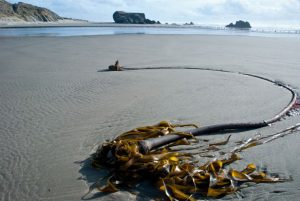
The Tokyo Electric Power Company (TEPCO) began releasing filtered wastewater from the site of the Fukushima Daiichi Nuclear Power Plant into the Pacific Ocean on August 24, 12 years after the 2011 Tōhoku earthquake and tsunami triggered meltdowns in three of the plant’s reactors. Despite assurances from TEPCO and the International Atomic Energy Agency (IAEA) that the treated water being discharged is relatively safe to release into the environment, the move has drawn major criticism from environmental groups, the Chinese government and citizens both in Japan and in neighboring countries.
On March 11, 2011, a 9.1-magnitude earthquake caused a major upthrust of the seafloor 72 kilometers (45 miles) off of the coast of Japan, generating a major tsunami; when it impacted the shore, the powerful wall of water inundated coastal communities, killing nearly 20,000 people, with over 2,500 still missing.
The 14-meter-high (46-foot) tsunami also overwhelmed the seawall of the Fukushima Daiichi Nuclear Power Plant, swamping the plant’s backup generators and causing the reactors’ cooling systems to fail, triggering meltdowns in units 1, 2 and 3—a nuclear incident second only to the Chernobyl Nuclear disaster that occurred in April 1986.
Since then, recovery teams have used large amounts of seawater to cool the melted blobs of nuclear material (called “corium”) that settled at the bottom of the reactors’ respective containment vessels, with the contaminated water being collected in large tanks at a complex dedicated to storing the material; to date, roughly 1.34 million tonnes (1.5 million US tons) have been collected at the facility.
Needless to say, this mass of contaminated water couldn’t be contained indefinitely, a fact that necessitated the development of the Advanced Liquid Processing System (ALPS), designed to remove radioactive material from the water, a process that is being monitored by the International Atomic Energy Agency (IAEA), the United Nations’ nuclear watchdog.
While ALPS is described as capable of scrubbing the water of 62 dangerous radionuclides such as caesium-137, iodine-131 and particles of nuclear fuel, it is unable to remove tritium from the mix: having two extra neutrons (where regular hydrogen consists only of a single proton and electron) tritium is a heavy isotope of hydrogen, meaning when it combines with oxygen it is chemically indistinguishable from ordinary water. Although the technology to extract the tritium exists, its concentrations are too low for the process to be practical.
Thankfully, compared to many of its longer-lived radioactive brethren, tritium has a half-life of only 12.32 years, meaning that in the nearly twelve and a half years since the Fukushima disaster only a little under half of the tritium present at the plant remains, with the remainder having decayed into non-radioactive helium-3.
However, it’s the remaining tritium that is concerning both Japanese citizens and the island nation’s neighbors, with demonstrators in China, Japan and South Korea protesting the release of the treated wastewater. The Chinese government has already placed bans on Japanese seafood imports from 10 prefectures, accusing Japan of treating the Pacific like a “sewer”, and imposed strict radiation tests on food imported from the rest of the country.
The environmental activist organization Greenpeace has gone a step further, and accused ALPS of being a flawed system that fails to properly rid the wastewater of contaminants, saying that the IAEA has “completely ignored the highly radioactive fuel debris that melted down which continues every day to contaminate ground water”; Greenpeace is citing a statement from the National Association of Marine Laboratories, who is criticizing the effectiveness of the ALPS process due to what they call “a lack of adequate and accurate scientific data supporting Japan’s assertion of safety.”
However, the proof may be in the pudding: University of Adelaide nuclear expert Tony Hooker points out that the amount of tritium present in the wastewater, 1,500 becquerels per liter (Bq/L), is now down to nearly one-seventh that of the 10,000 Bq/L limit the World Health Organization has set for drinking water.
“Tritium is regularly released from nuclear power facilities into waterways worldwide,” Hooker explained. “For decades (there have been) no evidential detrimental environmental or health effects.”
Subscribers, to watch the subscriber version of the video, first log in then click on Dreamland Subscriber-Only Video Podcast link.
Kyle Hill has a video outlining the history of the Fukushima meltdown that features stories of ghosts of the victims of the tsunami titled “The Fukushima Nuclear Disaster – Epidemic of Ghosts”:
https://youtu.be/4UHZugCNKA4?si=_oPSKy9UoTkgCr7r